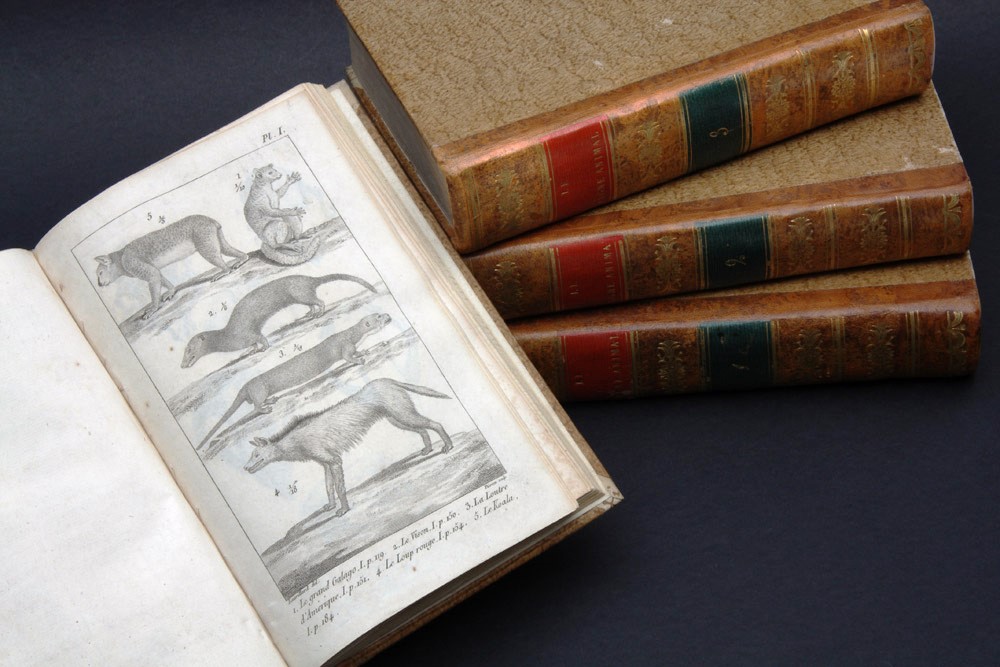Available Copies from Independent Booksellers

Price: US$1000.00 + shipping
Description: 4 vols. 15 engraved plates. 8vo, contemporary quarter sheep gilt and marbled boards. First edition. PMM 276. Old stamped ownership signature on each front free endpaper; some light rubbing to the bindings. A very attractive set. Half-titles present.
Seller: Jeffrey H. Marks, Rare Books, ABAA, Rochester, NY, U.S.A.

Price: US$2000.00 + shipping
Condition: Good
Description: 4 Volumes. 8vo. pp. xxxvii, 540; xviii, 532; xxix, 653; viii, 255. with half-titles. 15 engraved plates by Pierron after Laurillard. 10 folding engraved plates from another work bound in at end. contemporary quarter sheep, gilt backs (spines somewhat worn, several joints cracked, scattered foxing). bookplate (1825), ownership entry (1834) & rubberstamp on title of A.Chambion on titles. First Edition of Cuvier s most comprehensive work, which embodied the whole of his previous researches on the structure of living and fossil animals and laid the foundations of modern comparative anatomy. Here Cuvier introduced his famous classification system, according to which the animal kingdom is divided into four main groups, vertebrata , mollusca , articulata (insects, lobsters), and radiata (all remaining types). "This type theory is Cuvier s greatest contribution in the sphere of systematization and represents, although in a somewhat modified form, the basis of all subsequent animal classification." (Nordenskiöld) Opposing the current view that the structure of an animal determined its functions and habits Cuvier maintained that an animal s structure was due to its functions and habits. Throughj the exact study of the anatomy of living and fossil species, he could reconstruct extinct forms from a few surviving bones. At the end of Volume IV (pp. 95-170) is an important annotated bibliography of zoological literature. Brit. Museum Cat. of Natural History I 410. Brunet II 457 (incorrectly citing date 1816). Casey Wood 307. Dibner, Heralds of Science, 195. Nissen 1013. Nordenskiöld, History of Biology, pp. 339-41. Printing and the Mind of Man 276. Sparrow, Milestones of Science, 42, Plate 134, pp. 31-32. Waller 11796. Wellcome II 423 (incomplete). cfGarrison & Morton 327.
Seller: D & E LAKE LTD. (ABAC/ILAB), Toronto, ON, Canada

CUVIER, GEORGES. Le régne animal distribué d'aprés son organisation. Paris: Deterville, 1817.
Price: US$2100.00 + shipping
Condition: Very Good
Description: CUVIER, GEORGES (1769-1832). Le régne animal distribué d'aprés son organisation. Paris: Deterville, 1817. FIRST EDITION. Four volumes. 8 vo. Contemp. half lea. gilt with marbled boards and edges. xxxvii, (1), 540; xviii, (1), 532; xxix, (1), 653; viii, 255 pp. Fifteen engraved plates. Occasional light browning to text (the plates clean), piece torn away from outside margin not affecting text of leaf 319/320, vol. 2; a very good set. PMM 276. "The most influential exposition of the typological approach to animal classification, representing the greatest body of zoological facts that had yet been assembled; it served as the standard zoological manual for most of Europe during the first half of the nineteenth century. Using the taxonomic system that he had introduced in 1812., Cuvier divided the animal kingdom into four main types or 'embranchements': Vertebrata, Mollusca, Articulata and Radiata, each with its own subgroups. This represented an attempt at a 'natural' classification system, based upon the assumption that the characteristic interrelationship between an animal's function and structure placed it within an exclusive group (i.e., that species were 'real'), as opposed to the more artificial systems of the past." (H. F. Norman Lib. Cat. 567, also the headline quotation). In volume four is found on pp. 95 to 170 'Table alphabétique des auteurs cités', an annotated bibliography of zoological literature. D.S.B. 3: 521-528. Heralds of Science 195. Milestones of Science 42. Wood, p. 307. G-M 327 (3rd ed.).
Seller: Antiquarian Scientist, The, Westhampton, MA, U.S.A.

Price: US$3222.52 + shipping
Description: Four volumes, octavo, 15 engraved plates by C.-L. Laurillard a handsome set, with all four half-titles, in contemporary quarter calf over mottled papered boards, gilt, double spine labels in red & green. First edition of this germinal work of natural history, with three volumes by Cuvier himself, and the fourth an important study of insects by his friend and colleague Latreille. Recognised as the father of comparative anatomy, Cuvier published widely throughout his lifetime, but this was his most famous and influential work, and contained the results of all his previous research on the structures of living and fossil animals. It was based upon his vast knowledge of zoological anatomies, and in it he applied Linnæus' system of nomenclature and classification to the whole animal kingdom, in the process establishing his four great classes: vertebrate, molluscous, articulate, and radiated. Cuvier's work is a benchmark for many reasons, not least for the third volume present here, which is actually the work of Pierre André Latreille, Professor of Entomology at the Paris Museum: Latreille's contribution was not only a significant contribution to his field, but he had earlier been heavily involved in characterising the insects collected on the Baudin voyage to Australia and the Pacific. In the present volume, Latreille sought to update the foundation work of scholars including Fabricius within Cuvier's framework; as a result, Latreille included here many Australian insects including two, the 'Rhipcera' and the 'Heleus', noted for the first time. Cuvier, born in 1769, was invited by Geoffroy Saint-Hilaire to come to Paris in 1795. He took an appointment at the newly-formed Muséum nationale d'histoire naturelle, where he remained until his death from cholera in 1832. He had first publicly canvassed his new quadripartite schema of the animal kingdom in an 1812 presentation to the Academy of Sciences, but it was in this work that he first detailed how this proposed division worked in practice. Here, each of the classes is discussed in a separate volume, with volumes I, II and IV by Cuvier himself; his organizations of fish families in particular 'were so soundly based that they have become orders or suborders in present classification' (DSB). Throughout his career, Cuvier held to the premise of Le Règne Animal that the four branches were fundamentally different, and that any similarities between them were due entirely to common functions rather than common ancestry. He did not believe, that is, that there was any evolutionary adaptation, a stance which put him in open conflict with his contemporaries such as Buffon, Lamarck, and Geoffroy. This led to the famous debate between Cuvier and Geoffroy at the Académie Royale des Sciences in Paris in 1830. Cuvier's towering position in the French natural sciences should be seen in the context of a very cynical view of his ambitions towards intellectual ownership of the science on Freycinet's voyage, an idea explored in correspondence between Faujas de Saint Fond and Louis de Freycinet. .
Seller: Hordern House Rare Books, Surry Hills, NSW, Australia